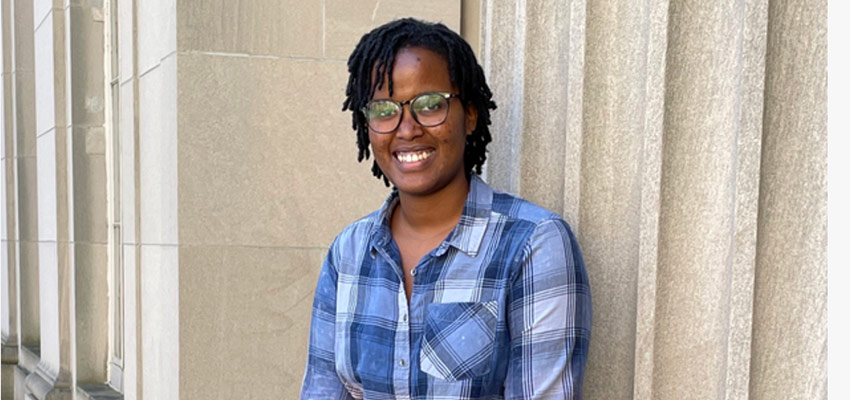
Senior Carene Umubyeyi seeks to advance sustainable structural design in her home country of Rwanda and beyond.
Growing up in Rwanda, Carene Umubyeyi learned at a young age the importance of community, adaptability, and education. At the age of 8, she moved to Michigan for a few years while her parents earned their graduate degrees. During that time, she had to learn a new language and integrate into a new culture. As challenging as it was to leave everything she grew to know and love, her earliest experience in the United States shaped her academic future.
Umubyeyi fondly recalls when her mom would pick her up from school and then stop by the lab or take her to the greenhouse and explain her research experiments. Umubyeyi’s parents are both survivors of the Rwandan Genocide who furthered their education abroad in agriculture and macroeconomics before returning to work in Rwanda, with the desire to contribute to the country’s development after the genocide.
“My parents modeled what service-oriented career paths look like, and as a result my own academic and career interests have always been shaped from a service perspective. I’m trying to understand how I can use what I'm learning to serve others in a more tangible way,” says Umubyeyi, who is now a senior studying civil and environmental engineering. She hopes to use the knowledge she has gained during her time at MIT to expand and educate on sustainable structural design and building methods in her home country of Rwanda and elsewhere in Africa.
Before coming to MIT, Umubyeyi interned with architects in Rwanda who introduced her to sustainability in the built environment. She learned about the different ways construction methods and material choices could be adapted to lower embodied carbon while also making use of local, more affordable materials in the process. She also credits her high school teachers in Rwanda who encouraged her curiosity to ask questions, and to really understand why things work.
While a first-year student at MIT, she was still deciding on a major and sought out every opportunity to explore her interests through undergraduate research opportunities (UROPs). Her first UROP was at MIT D-Lab, which works with community partners around the world to develop collaborative approaches to global poverty challenges. “I was very drawn to the idea of applying what I was learning to work with communities in different parts of the world” she recalls.
Her first project was with D-Lab research engineer Eric Verploegen and his group developing evaporating cooling technology for farmers in off-grid areas to chill and preserve their produce for longer periods of time. She continued her UROP with Verploegen for two years and traveled to Kenya and Rwanda with the research team to meet with community partners and farmers. “It was really valuable to learn how to engage communities in the research process, to obtain their feedback, and understand their needs and challenges in order to advance the work,” she says. Umubyeyi also worked with Susan Murcott, another research environmental engineer at D-Lab, on a project that involved assessing the water and sanitation (WASH) challenges in four rural cells located in Rwanda’s Northern Province, with the goal of providing feasible water supply recommendations to partner institutions and municipal authorities.
When she was finishing her first year, she participated in the Department of Civil and Environmental Engineering’s summer research program Materials in Art, Archaeology and Architecture (ONE-MA3). In this program, MIT undergraduates conduct three weeks of fieldwork in Italy to learn how to improve the sustainability of infrastructure from studying ancient Roman structures as a prerequisite for class 1.057 (Heritage Science and Technology). She attended one of the program’s lectures by John Ochsendorf, professor of architecture and civil and environmental engineering, who discussed his group’s research on analyzing historic masonry structures, structural form-finding, and construction methods that rely on sustainable, locally sourced materials. His lecture planted the seeds for her academic trajectory in civil and environmental engineering and reaffirmed her love for structures, from the creative design aspect to the technical understanding of how structural systems behave.
“I remember when I went to the lecture I was completely blown away,” she says of the first time she saw her interests in structures, architecture, and global development intersect. She went on to pursue two UROP projects with Ochsendorf and considers him a mentor who inspired her to develop her interests in structural design and sustainable material use as a way to address global housing affordability challenges in developing countries and emerging economies.
What Umubyeyi appreciates most about MIT is the incredible fieldwork experiences and mentors she’s had in each of her UROPs. She remembers one of the pieces of advice that the upperclassmen said during her first-year orientation, “always make sure to approach faculty and talk to them.” And at the time, she remembers thinking as a first-year, “I don't know if I have the courage to approach professors.” But now, as a senior, she would give that same advice to an incoming first-year. “Find great mentors and participate in UROPs with advisors who are doing work that aligns with what you're hoping to learn. These experiences will mold and shape your own interests as you go along,” she says.
After graduating, Umubyeyi plans to continue with graduate school to further her knowledge in structures and engineering. She’s even open to the idea of one day teaching herself.
“Knowing how much I appreciated having really great professors and mentors, I’m also drawn to doing the same for others, especially back home in Rwanda,” she says. “I think it would be really interesting if I contributed there as both an educator and a practitioner. But I’m open to opportunities as they come along.

